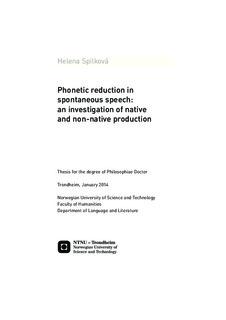| dc.description.abstract | The aim of this thesis is to investigate the patterns of phonetic reduction (i.e. phenomena resulting from a decrease of articulatory effort) in spontaneous non-native production. To address this issue, two studies are carried out describing changes in selected phonetic parameters across domains typically associated with varying degrees of phonetic reduction. The speech materials recorded for the purposes of the present investigation included primarily spontaneous task-based dialogues in Czech, Norwegian, and English spoken by native and non-native (Czech and Norwegian) speakers. In addition, read speech in English produced by the three speaker groups with different native language (L1) background was recorded.
The first study aimed to describe the effect of speaking style (read vs. spontaneous speech) on temporal and spectral properties of the English function words in, of and to in productions of native speakers and two groups of non-native speakers (Czech and Norwegian speakers). The results showed that many of the phonetic parameters observed in the function words were significantly influenced by speakers’ L1 background. The patterns of L1 effect, however, differed between the three observed words. While for the preposition in, none of the observed variables were found to vary depending on speakers’ L1, in the words of and to, longer word durations in (some) non-native speakers’ productions, and longer vowel durations as well as more peripheral vowel qualities in word tokens produced by non-natives as compared to native productions were revealed. This pattern of results seems to indicate non-natives’ insufficient awareness of the so-called weak form words (of and to) resulting in their insufficient reduction. Further, a number of phonetic parameters were found to vary between the two investigated speaking styles, consistently across the speaker groups. However, only some of these parameters may be reliably related to a varying degree of production effort and precision. For example, shorter word durations, higher proportions of vowel and higher proportions of voicing within the fricative in the preposition of, or relatively shorter durations of plosive closure in the preposition to, in spontaneous as compared to read speech, may be seen as lenitions resulting from a decrease of articulatory effort in spontaneous speech. On the other hand, several other variables affected by speaking style were identified that are apparently related to different aspects of speaking style than production precision.
The second study investigated the reduction of repeated mentions of content words in the course of a dialogue comparing native productions (in Czech, English and Norwegian) and productions in non-native English spoken by Czech and Norwegian speakers. The study focussed on durational, rhythmical and spectral aspects of reduction in the observed words. The results showed a consistent durational as well as spectral reduction of the repeated mentions of content words in all L1 productions, as well as in the English spoken by non-native speakers. However, a deviating pattern in the English productions of the Czech speaker group was revealed in the analysis of a rhythm-related measure (expressing the ratio of unstressed and stressed syllable durations). Here, the Czech speakers produced unusually long unstressed syllables resulting in noticeably higher unstressed-to-stressed syllable duration ratios in the first mentions of content words. In contrast to that, the ratio of unstressed and stressed syllable durations did not change much between the first mention and repeated mentions in the productions of natives and Norwegian speakers of English. This peculiar rhythmical pattern of hyperarticulation of first mentions of polysyllabic words is likely due to substantial differences in the phonological properties related to rhythm type between Czech on one side, and English and Norwegian on the other. | nb_NO |
